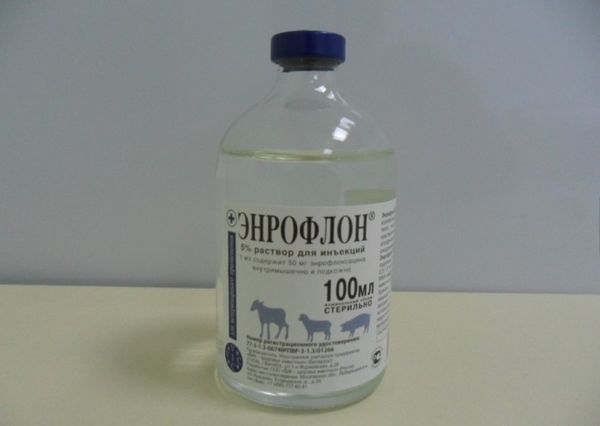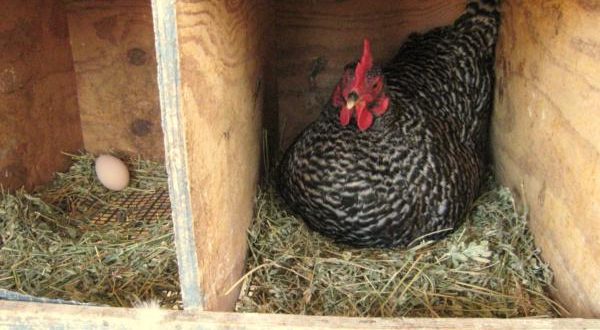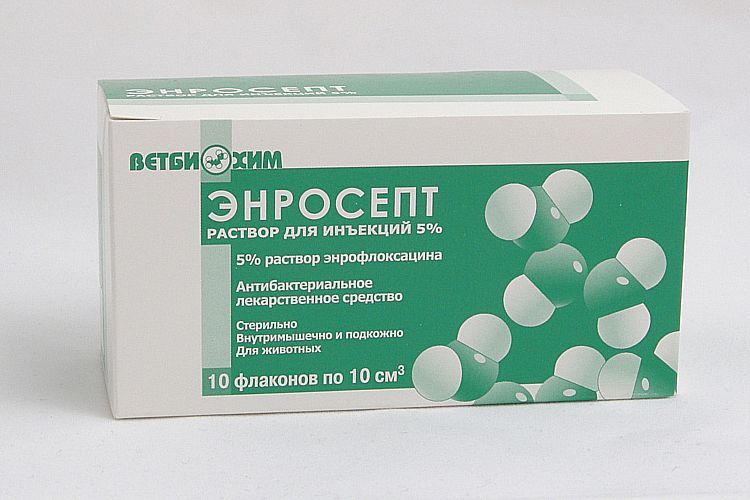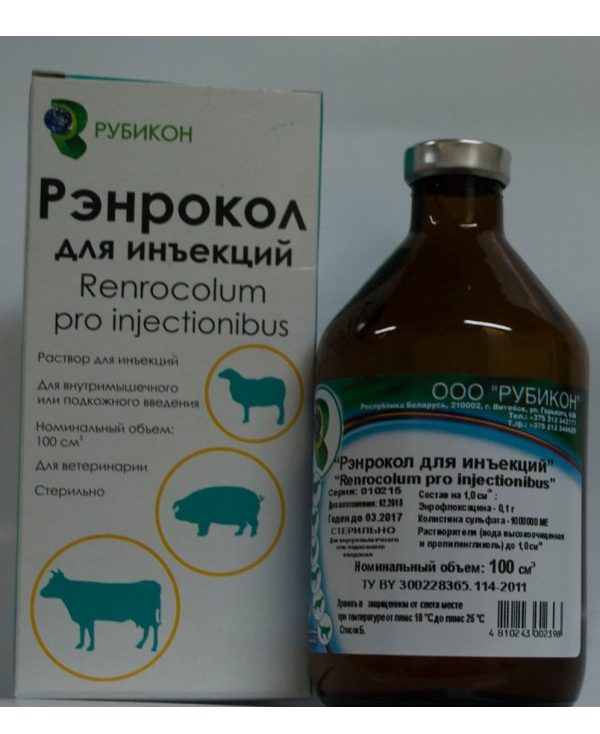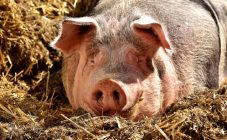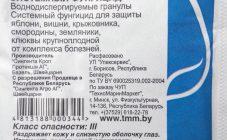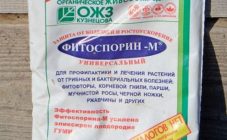Content:
The success of poultry breeding is directly related to its health. Infectious diseases often affect both chickens and adults. Sometimes a bird can cope with an illness on its own thanks to high-quality nutrition, proper arrangement of the poultry house. But some infections do not pass without a trace: some calm down for a while, so that next time they appear with renewed vigor, others are aggravated immediately, leading to death. Therefore, for prevention, it is better to drink the chickens from the first days of life with strengthening agents so that they are not afraid of any infection. Enroflon is just such a drug, the dosage and contraindications of which will be described below.
Enroflon: instructions for use for birds
The antibiotic enroflon for birds is strongly recommended to solder daily chicks for preventive purposes. The medicine prevents the appearance of many infectious diseases, due to which the offspring grows up healthy. It is especially important to administer medicine when the chicks gain access to free range. There are always a lot of insects on the ground, and some of them can serve as carriers of infections. Newborns are very sensitive to various infections. And one sick chick can infect the entire brood.
The most dangerous days of the chick life period:
- 1-5;
- 20-25;
- 35-40.
At these moments, the bird is especially vulnerable to respiratory and gastrointestinal pathologies. In this case, the antibiotic enroflon for chickens:
- in case of respiratory diseases, it acts as an anti-inflammatory, reducing the risk of viral infections;
- has a beneficial effect on the microflora, saturating the body with the necessary components.
When using enroflon for chickens, the instruction guarantees getting rid of salmonellosis, mycoplasmosis and other infections.
Enroflon for broilers
Enroflon medicinal product for broilers is very important. These birds have weak immunity, so they often catch various infections. The instructions for use of enroflon for broiler chickens say that the drug can be given if:
- the chicken sits ruffled, apathetic to everything;
- wheezing when breathing is heard at a distance;
- pus comes out of the eyes;
- the stool becomes liquid and takes on an unusual color;
- the beak is slightly open and there is mucus on it.
Enroflon for laying hens
An adult bird is much stronger than chicks, but the introduction of a new individual in the house can nevertheless pose a problem. You can buy a sick bird from an unscrupulous seller, thereby endangering all the livestock of the yard. The laying hen will catch the infection very quickly. This is facilitated by great overcrowding, poor nutrition, stagnant air in the room.
Enroflon preparation for adult birds is indicated for:
- bronchopneumonia;
- colibacillosis;
- microplasmosis;
- salmonellosis;
- enteritis;
- respiratory pathologies.
Description and characteristics of the drug
The antibiotic is presented in the form of a slightly cloudy yellow liquid. For a person, it is almost not dangerous.Enrofloxacin, which has an antibacterial and antimycoplasmic mechanical effect, is declared as active in the preparation. The active ingredient slows down the enzymatic reaction of the bacteria itself and blocks the adaptation of viruses to the drug.
Colistin sulfate prevents the spread of microorganisms, weakens their defense system.
The medication guide guarantees:
- improving digestion;
- prevention of serious infections;
- saturation with useful substances;
- increased immunity.
Side effects
Sometimes there is an allergic reaction to the fluoroquinolones present in the drug. In this case, the medicine must be replaced with antihistamines.
Contraindications
If the bird is diagnosed with renal impairment, liver damage, then enroflon should not be given to drink. Birds during this period are limited to exposure to the sun.
It is also not recommended to use enroflon for laying hens, but if treatment cannot be avoided, then eggs are not eaten.
It is categorically impossible to combine taking an antibiotic with drugs:
- iron-containing;
- with aluminum;
- bacteriostatic type;
- theophyllines;
- magnesium and calcium;
- anthracid;
- sucralfates;
- anticoagulants;
- steroids.
Poultry can be slaughtered after treatment after 11 days. Until this time, the carcasses should never be eaten. They can be fed to dogs or processed into meat and bone meal.
Pharmacology
The drug suppresses very many viruses, their immunity to the antibiotic is practically not developed.
How to dilute an antibiotic
Against various digestive disorders and in preventive measures, it is suggested to use enroflon in the form of a 5% or 10% solution. The medicine is added to feed or drinkers.
How to breed enroflon for chickens
Having bought enroflon, before diluting it, you should read the instructions. Dosage of 10% of the drug: add only 0.5 ml to 1 liter of water. Treatment procedures are carried out continuously for 3-5 days.
How to give Enroflon to broilers
In its pure form, the dose of antibiotic for broilers is from 2.5 to 5 mg per 1 kg of live weight of the bird. When drinking, a 10% solution is added to the water at the rate of 0.5 ml per 1 kg of the weight of the individual.
How to feed chickens with enroflon
Adult birds should be drunk with 5% or 10% solution diluted in water. Add 1 ml of medicine to 1 liter of pure water. The duration of the course is 3-5 days.
In each case, the drug is diluted only in the right amount of water so that the birds can drink it in a day. A fresh solution is prepared the next day. During the treatment, the birds are not given pure plain water.
Enroflon can be replaced, if necessary, with any of the analogs: baytril, enrofloxacin, enrosept, enroflox.
Frequently asked questions about the drug
Very often, novice poultry farmers have questions regarding drug treatment.
What are the features of Enroflon 10
The oral antibiotic enroflon 10 has a special direction - it eliminates mycoplasma and bacterial diseases. The active ingredient enrofloxacin inhibits bacterial DNA gyrase, disrupting their division, and changes morphology. Gram-negative microorganisms are exposed during division and during rest, and gram-positive microorganisms during division.
Enroflon 10 has a very broad antimycoplasmic antibacterial effect on gram-negative and positive microorganisms.
The medicinal solution is used against:
- enzootic pneumonia;
- enteritis;
- mycoplasmosis;
- colibacillosis;
- atrophic rhinitis;
- bronchopneumonia;
- salmonellosis. In this case, the therapeutic dose is necessarily doubled.
The correct dosage does not cause complications from taking the antibiotic. Do not give the drug if the bird has liver problems.
Which of the analogs of Enroflon is better
Ranrocol is a clear blue liquid. The preparation contains enrofloxacin and colistin sulfate.
Pharmacology
The active substance of enroflon prevents the production of malic acid in microorganisms, has a bactericidal effect.
The highest concentration occurs after 30 minutes. after taking an antibiotic. The therapeutic level of the drug is valid for 1 day. Renrocol easily penetrates into any organ and tissue of the body, providing positive effects.
Colistin sulfate belongs to the antibiotics of the polymyxin group. The action of the antibiotic is aimed at destroying the cytoplasmic membrane of the microbe cells. The drug is not absorbed in the gastrointestinal tract, it has an antibacterial effect at the location.
The combination of active substances in the composition of renrocol has a broad antibacterial effect, suppressing microorganisms:
- rickettsia;
- mycoplasma;
- leptospira;
- klebsiella;
- streptococci;
- pasteurell;
- escherichy;
- chlamydia;
- listeria;
- hemophilus;
- bordetell;
- staphylococci;
- salmonella.
Application of the drug
Renrocol is mixed with water and a freshly prepared solution is daily soldered to the bird. Give a drink in the morning, dosage: 0.5 ml per 1 liter of filtered water. The entire period of preventive drinking (3-5 days), the solution should remain the only source of drinking, access to others should be limited.
Contraindications
In no case should Renrocol be combined with chloramphenicol, tetracycline, macrolides. Non-steroidal anti-inflammatory drugs are also banned.
Laying hens is a contraindication for antibiotic administration. Safe slaughter is carried out no earlier than 12 days after the final drinking.
If in doubt about the correct dosage, the best option is to consult a veterinarian. He will accurately prescribe a course of treatment every day.
Treating poultry is not an easy process. It is very important to monitor the condition of the birds so as not to miss the first symptoms of diseases, and then start treatment in a timely manner to avoid the spread of infection in the hen house. But all this can be avoided if, for prophylactic purposes, the pets are drunk with Enroflon.
